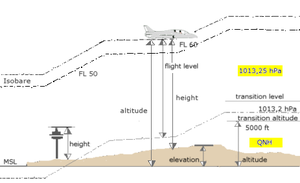Altitude is the elevation of a point or object from a known level or datum (plural: data). Common data are mean sea level, local ground level (Above Ground Level, or AGL), or the surface of the WGS-84 geoid, used by GPS. In aviation, altitude is measured in feet. For non-aviation uses, altitude may be measured in other units such as metres or miles.
Atmospheric pressure decreases as altitude increases. This principle is the basis of operation of the pressure altimeter, which is an aneroid barometer calibrated to indicate altitude instead of pressure. It is the fall in pressure that leads to a shortage of oxygen (hypoxia) in humans on ascent to high altitude.
Altitude in aviation
In aviation, the term altitude can have several meanings, and is therefore qualified by either explicitly adding a modifier (e.g. "true altitude"), or implicitly through the context of the communication. Parties exchanging information concerning this topic must be clear which definition is being used.[1]
- True altitude is the elevation above mean sea level. In UK aviation radiotelephony usage, the vertical distance of a level, a point or an object considered as a point, measured from mean sea level; this is referred to over the radio as altitude.(see QNH)[2]
- height is the elevation above a ground reference point, commonly the terrain elevation. In UK aviation radiotelephony usage, the vertical distance of a level, a point or an object considered as a point, measured from a specified datum; this is referred to over the radio as height, where the specified datum is the airfield elevation (see QFE)[2]
- Absolute altitude is the height of the aircraft above the terrain over which it is flying.
- Indicated altitude is the reading on the altimeter.
- Pressure altitude is the elevation above a standard datum plane (typically, 1013.25 millibars or 29.92" Hg and 15°C). Pressure altitude divided by 100 feet is referred to as the flight level, and is used above the transition altitude (18,000 feet in the US, but may be as low as 3,000ft in other countries); so when the altimeter reads 18,000 ft on the standard pressure setting the aircraft is said to be at "Flight level 180". When flying at a Flight Level, the altimeter is always set to standard pressure (29.92 / 1013.2). Below the transition level, altitudes are read in thousands, pronounced "one three thousand" for 13,000, "seven thousand" for 7,000 etc.
- Density altitude is the altitude corrected for non-ISA International Standard Atmosphere (ISA) conditions at which the air density is unequal to ISA conditions. Aircraft performance depends on density altitude, which is affected by barometric pressure, humidity and temperature. On a very hot day, density altitude at an airport may be so high as to preclude takeoff, particularly for helicopters or a heavily loaded aircraft.
Altitude regions
Although the term altitude is commonly used to mean the height above sea level of a location, in geography the term elevation is often preferred for this usage.
Mountain medicine recognizes three altitude regions:[3]
- High altitude = 1500 m – 3500 m (5000 – 11,500 ft)
- Very High altitude = 3500 m – 5500 m (11,500 – 18,000 ft)
- Extreme altitude = 5500 m – above
Travel to high altitudes can lead to medical problems, from the mild symptoms of acute mountain sickness to the potentially fatal high altitude pulmonary oedema (HAPE) and high altitude cerebral oedema (HACE). These conditions are caused by the profound hypoxia associated with travel to high altitudes.
The Earth's atmosphere is divided into several altitude regions:[4]
- Troposphere — surface to 8000 m / 5 miles at poles – 18.000 m / 11 miles at equator, ending at the Tropopause.
- Stratosphere — Tropopause to 50 km /31 miles
- Mesosphere — Stratopause to 85 km /53 miles
- Thermosphere — Mesopause to 675 km / 420 miles
- Exosphere — Thermopause to 10,000 km /6200 miles
References
- ^ (1 December 1989) Air Navigation. Department of the Air Force. AFM 51-40.
- ^ a b (1 January 1995) Radiotelephony Manual. UK Civil Aviation Authority. CAP413.
- ^ "Non-Physician Altitude Tutorial". International Society for Mountain Medicine. Retrieved on 22 December, 2005.
- ^ "Layers of the Atmosphere". JetStream, the National Weather Service Online Weather School. National Weather Service. Retrieved on 22 December, 2005.
External links
- "Altitude pressure calculator". Apex (altitude physiology expeditions). Retrieved on 8th August, 2006.
- "The Race to the Stratosphere". U.S. Centennial of Flight Commission. Retrieved on 25 January, 2006.
- Downloadable ETOPO2 Raw Data Database (2 minute grid)
- Downloadable ETOPO5 Raw Data Database (5 minute grid)
- Calculate true altitude with these JavaScript applications

No comments:
Post a Comment